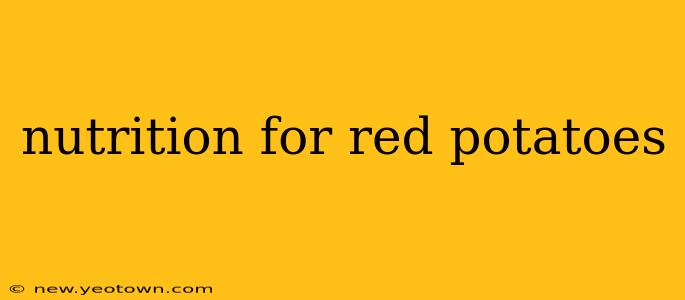The red potato. Often overshadowed by its russet cousin, this vibrant spud deserves a spot in the spotlight. It's not just a delicious side dish; it's a nutritional powerhouse packed with vitamins, minerals, and fiber. Let's dig into the nutritional profile of this often-underestimated vegetable and explore why it deserves a prominent place in your diet.
My journey into the world of red potatoes started with a simple question: Are they really as healthy as people claim? I dove into research, consulted nutritional databases, and even experimented with different cooking methods to truly understand the nutritional benefits. What I discovered surprised me. The red potato isn't just a carbohydrate source; it's a surprisingly versatile and nutrient-rich food.
What are the nutritional benefits of red potatoes?
Red potatoes boast a respectable amount of essential nutrients. They’re a good source of vitamin C, an antioxidant crucial for immune function and collagen production. They also contain potassium, an important mineral for maintaining healthy blood pressure. The fiber content aids digestion and promotes satiety, helping you feel fuller for longer. Beyond that, they offer modest amounts of vitamin B6 and manganese.
Are red potatoes good for weight loss?
This is a common question, and the answer is nuanced. Like any food, the impact on weight loss depends on portion size and overall diet. Red potatoes, while containing carbohydrates, are also a source of fiber, which can contribute to feelings of fullness and potentially reduce overall calorie intake. However, they shouldn’t be considered a "magic bullet" for weight loss. A balanced diet and regular exercise remain crucial. Choosing healthy cooking methods, such as baking or boiling, instead of frying, minimizes added fats and calories.
How many calories are in a red potato?
The calorie content of a red potato varies depending on size. A medium-sized red potato (about 5.3 ounces) typically contains around 110 calories. This is a relatively low calorie count for a filling food. However, adding butter, sour cream, or cheese dramatically increases the calorie count, so be mindful of toppings.
What are the best ways to cook red potatoes?
The beauty of red potatoes lies in their versatility. They can be boiled, roasted, baked, or even grilled. Baking or boiling are generally healthier options as they minimize added fats and oils. Roasting brings out a delicious sweetness, while boiling allows for easy incorporation into salads or other dishes. Experiment to find your favorite method!
Are red potatoes healthier than white potatoes?
This is often debated, and the truth is, both offer nutritional benefits. Red potatoes tend to have slightly higher levels of antioxidants due to their red skin, which contains anthocyanins, compounds associated with various health benefits. However, white potatoes also provide essential nutrients. The best choice depends on personal preference and dietary needs.
Do red potatoes contain gluten?
No, red potatoes are naturally gluten-free. This makes them a suitable option for individuals with celiac disease or gluten sensitivity. However, always check the ingredients of any added seasonings or sauces, as they might contain gluten.
My exploration into the nutritional world of the red potato has revealed its hidden depths. It’s more than just a simple side dish; it's a versatile and nutritious food that deserves a place in a balanced diet. So, next time you're planning a meal, don't underestimate the humble red potato – it might just surprise you.

